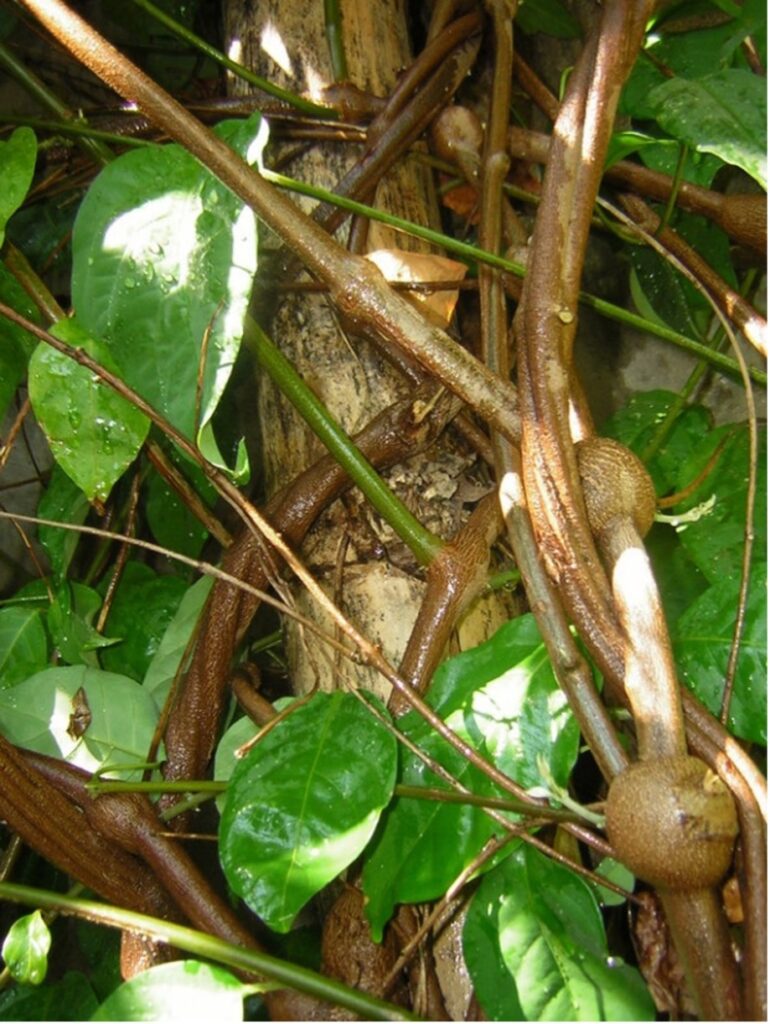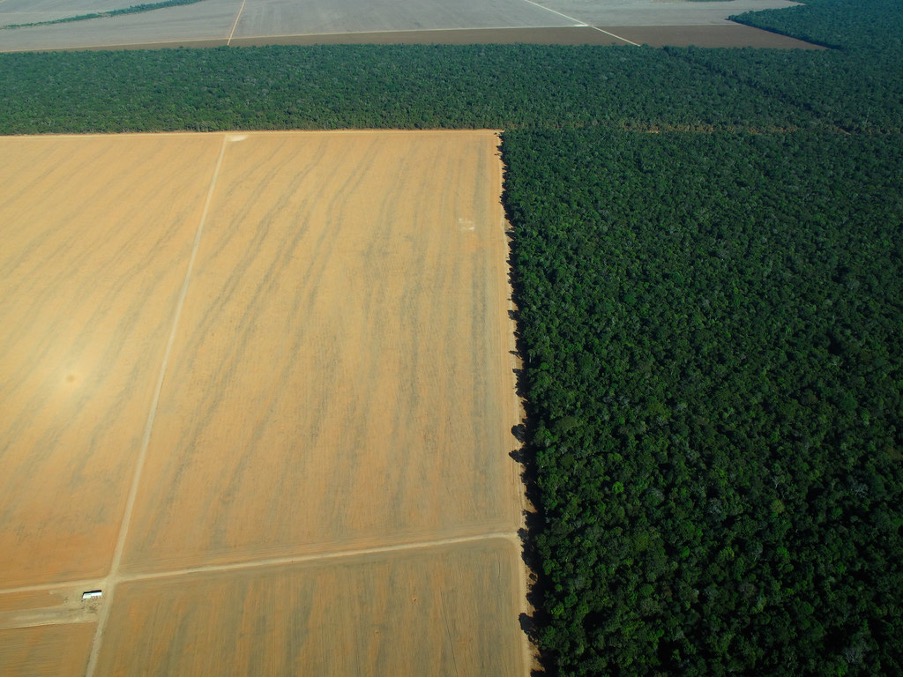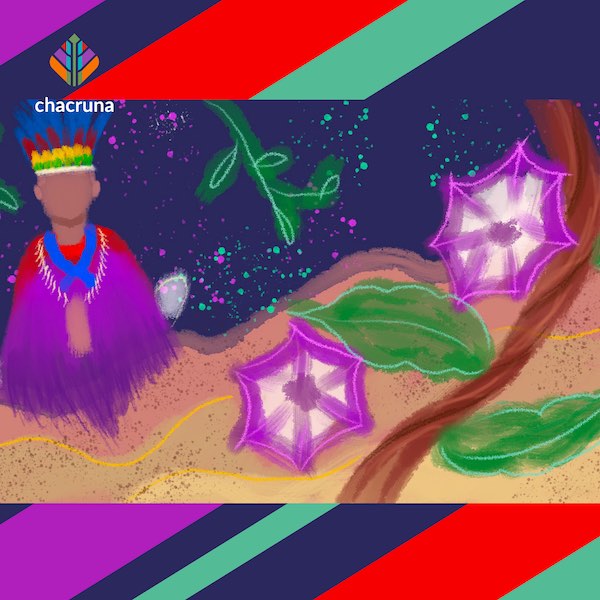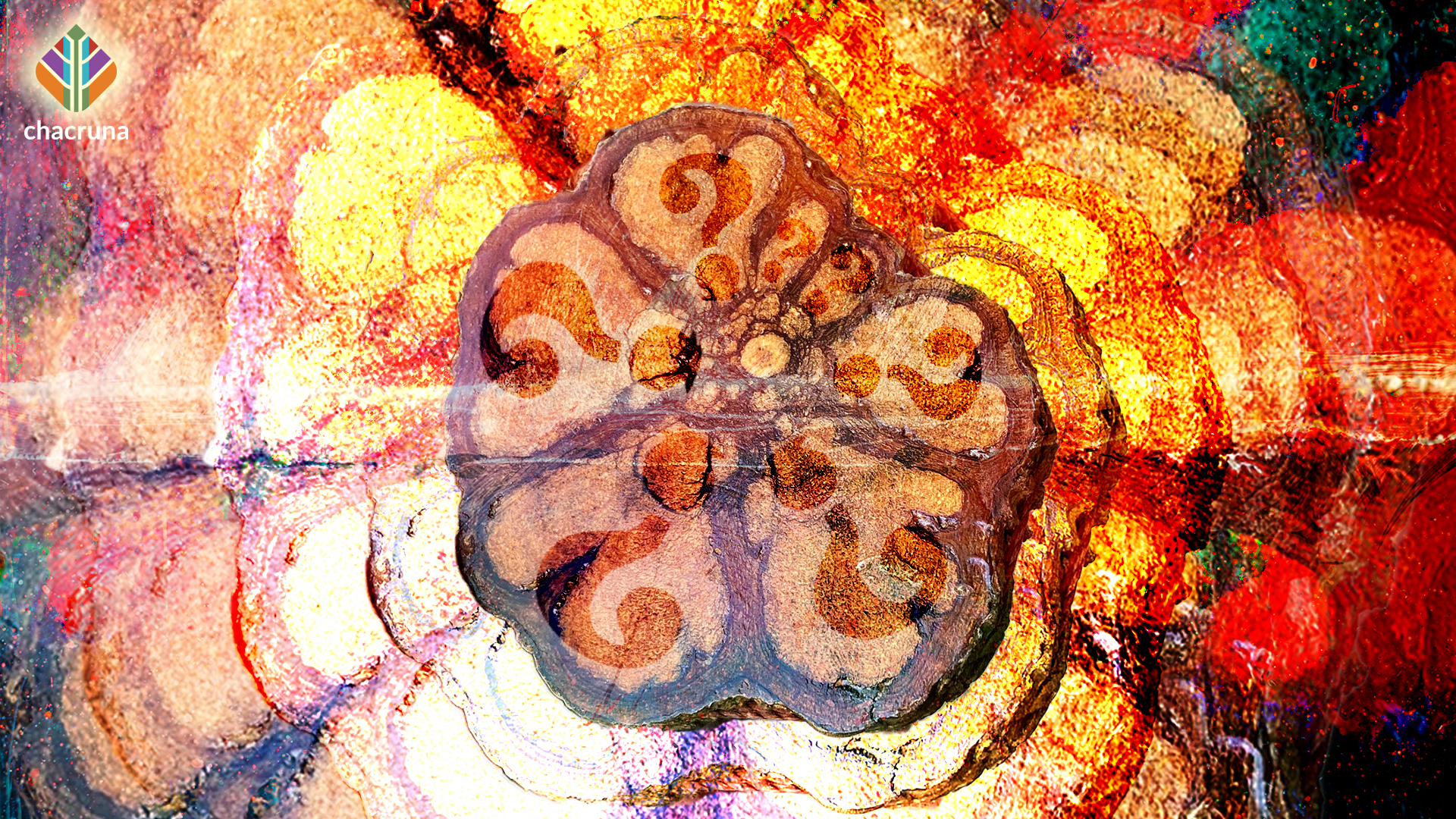Ayahuasca is a drink made of two or more plants, one with psychedelic DMT (N,N-dimethyltryptamine), and another with harmala alkaloids. The exact composition of the brew depends on the locality and tradition, but most commonly, it is prepared by stewing the bark of the Banisteriopsis caapi vine, which contains harmala alkaloids, with the leaves of the Psychotria viridis (chacruna, or chacrona) or Diplopterys cabrerana plants (sometimes called chaliponga or chagropanga), which contain DMT. Mimosa tenuiflora, also called “jurema,” can be used instead of chacruna, and is more common in some regions of Brazil. Other medicinal plants such as Justicia pectoralis (tilo), Nicotiana rustica (tobacco), Brugmansia (angel’s trumpet), or even Datura (thornapple, jimsonweed) are sometimes added, although less commonly.
Traditionally used among many Amazonian indigenous groups, the B. caapi vine is considered to be the central part of ayahuasca; in Santo Daime, União do Vegetal (UDV), and Barquinha, the vine and chacruna seem to be considered equally relevant in the preparation. Indeed, the word “ayahuasca” in the Quechua language means, “vine of the soul” and refers both to Banisteriopsis caapi and to the whole drink containing various additional plants. In this review, I will focus mainly on Banisteriopsis caapi, and, to avoid confusion, will use “ayahuasca” to refer to the brew, and the word “caapi” to describe the plant (although it has a variety of regional names, e.g., in Brazil, it is known as jagube or mariri).
Banisteriopsis caapi (Family: Malpighiaceae) first became known to Western science in 1852, through description by Richard Spruce. When traveling in Colombia, he witnessed Tukano people of the Vaupes region using a plant referred to as “capi” in the preparation of a hallucinogenic drink (Spruce, 1873).

Banisteriopsis caapi is found in the forests of the northwestern Amazon (Brazil, Bolivia, Colombia, Ecuador, Peru), the Orinoco Basin of Venezuela, and Pacific coastal areas of Colombia and Panama (Schultes, 1977). The territory of natural occurrence of these species in the Amazon rainforest is still little known because the area has barely been surveyed. It is hard to determine where caapi originated; it is possible that it had been cultivated and that it may have been spread deliberately by the Indigenous groups that had used it for centuries, since pre-Colombian times (Gates, 1982).
One of the biggest studies comparing chemical composition between different varieties of caapi conducted by Santos et al. (2020) demonstrates considerable variation in the relative proportions of harmala alkaloids between different varieties of caapi, confirming the fact that different varieties produce different effects.
People who use ayahuasca traditionally distinguish different kinds of ayahuasca vine, an “enigma” that puzzled famous ethnobotanist, Richard Evans Schultes, who recognized all these vines as the same species, Banisteriopsis caapi. According to traditional knowledge, these varieties have very different properties and uses in the resulting ayahuasca beverage, and can be identified reliably and consistently, even from a distance, without touching the plant (Schultes, 1986; Sheldrake, 2020). Yet, botanists consider the ayahuasca vine a single species, and Schultes remarked that he was not able to tell these varieties apart. However, more recently, researchers from Brazil documented distinguishing characteristics of these varieties, calling for reassessment of species taxonomy (Oliveira et al., 2018). Some of these features are: the leaf color; the arrangement of very small glands on the leaves; bark color; the stem consistency; the presence or absence of inflated nodes in the stems, as well as the color of the resulting beverage. Regina de Oliveira stresses that, “for the conservation of the vine, and consequently, the development of ayahuasca communities, culture, and ceremonies, we must maintain this diversity of all forms.” This fusion of ethnobotanical and taxonomic studies is just the beginning, and, for now, B. caapi is still considered a single species, the type specimens for which has only recently been described by Oliveira et al., (2021). It would not be a surprise if further research reveals that these are separate species. According to Gates (1982), among the genera of Malpighiaceae family, Banisteriopsis is considered one of the most complex due to the high number of species of vines, 92 (de Frias et al., 2012), many of which have similar appearance. But looks are not the only differentiating feature between caapi varieties; they also likely contain different alkaloids. For example, one of the biggest studies comparing chemical composition between different varieties of caapi conducted by Santos et al. (2020) demonstrates considerable variation in the relative proportions of harmala alkaloids between different varieties of caapi, confirming the fact that different varieties produce different effects.

And what does research into species distribution, population density, and caapi’s conservation status show? B. caapi is not listed or assessed by the International Union for Conservation of Nature (IUCN) and there aren’t many peer-reviewed articles or high-impact reports on these topics. So, to find out about the situation with ayahuasca, I’ve spoken to several researchers and looked at any other available sources of information, such as newspaper articles, interviews, and blog posts.
In Brazil, both caapi and chacruna plants have been successfully cultivated to satisfy considerable demand from the syncretic religions, Santo Daime and União do Vegetal, although collection from the wild also continues

The picture that emerged differed from place to place. Iquitos is generally considered the center of ayahuasca tourism, with thousands of people attending retreat centers in its vicinity (Kilham, 2018). The main supply of the wild-harvested vine for Iquitos comes from Pucallpa, a smaller town located five days south along the Ucayali River. From Pucallpa, the vine is commonly harvested from the nearby Imiría Conservation Reserve (Francuski, 2021). Several online articles describe local shortages around Iquitos and Pucallpa (Opray, 2017; Samadhi.Today, 2018). These local shortages manifest in decreased vine size (indicating that the vines do not have time to regenerate), which affects their quality for brewing and their medicinal properties. Moreover, it is necessary to venture further and further to find “wild” vines, which are preferred by some. Carlos Suárez Álvarez, an ethnographer and author, recently sounded a warning that ayahuasca is being harvested at an alarming rate (Suárez Álvarez, 2020). In Brazil, both caapi and chacruna plants have been successfully cultivated to satisfy considerable demand from the syncretic religions, Santo Daime and União do Vegetal, although collection from the wild also continues. Some states in Brazil (e.g., Acre and Rondônia) have environmental legislation in place that, in theory, addresses the regulation of the extraction and transport of caapi and chacruna. Religious organizations must obtain registration, get licenses, and present reforestation plans. There are also quotas in place on how much plant material is allowed to be extracted from the wild. The limitations do not apply to the plants cultivated on private lands, thus encouraging cultivation. Importantly, harvesting by traditional and Indigenous communities in their own territories is exempted from licensing. Although not without significant limitations, such as failure to include more actors and groups in the development of these regulations, as discussed by Antunes and Antunes, 2021, such legislation could have been a first step for sustainable production and environmental protection. However, given the anti-environmental policies of the current Brazilian president, Jair Bolsonaro, deforestation has picked up, particularly in the states of Pará, Mato Grosso, and Rondônia. These states are located in the so-called “deforestation arc,” where about 75% of all legal deforestation is happening in Brazil (Fearnside et al., 2009; Carrero et al., 2022). As of 2021, PRODES reported 13,000 square kilometers of forest loss, a 185% increase from 2012, the lowest deforestation rate on record. Moreover, even in Acre, the only state with such regulations, there is a lack of enforcement, as environmental agencies do not have the capacity to stop illegal deforestation and resource extraction (Meyer, 2021).
But what about other areas? To find out about Colombia, I spoke with David Rodriguez-Mora, a doctoral student at the University of Texas, San Antonio, who focused his research on the botany and taxonomy of the medicinal plants used by the Cofan in southwest Colombia. Although the Cofan lost about 95% of their ancestral territory, their knowledge of plant use is still tremendous. Yagé, as ayahuasca is known in Colombia, is an integral part of their spirituality, and the Cofan have been cultivating yagé for a very long time. According to David, overharvesting of caapi is not yet a problem in that part of the world. Local communities traditionally managed harvesting very well; the issues described above, in Peru and Brazil, arose with commercialization and globalization. Social and ecological systems take time to adapt to increasing harvesting pressure and global demand. However, Colombia has its own threats to yagé, such as oil extraction, fragmentation of the Indigenous territories, expansion of cattle farming, agriculture, and coca cultivation with associated fumigation (Mowbray, 2022).
Popularization of ayahuasca’s potential medical benefits can lead to other unintended consequences. For example, a study published in 2019 in Conservation Biology, found that the ayahuasca tourism boom could be one of the drivers of jaguar poaching.
Popularization of ayahuasca’s potential medical benefits can lead to other unintended consequences. For example, a study published in 2019 in Conservation Biology, found that the ayahuasca tourism boom could be one of the drivers of jaguar poaching. Through discussions with street vendors, shamans, and individuals working in the tourism industry, researchers found that jaguar canine pendants, jaguar skin bracelets, and other jaguar products are being sold to tourists under the pretense that they somehow enhance the ayahuasca experience (Braczkowski et al., 2019).

The reasons why most ayahuasca cultivation happens as an agroforestry, rather than more traditional monoculture system, is two-fold: first, both caapi and chacruna naturally need other plants around—for support and shade respectively—and, second, ayahuasca religions’ spiritual connection with nature, amplified by the use of ayahuasca, promotes pro-ecological behaviors

Discover the Indigenous Reciprocity Initiative of the Americas
On the plus side, the expansion of the ayahuasca religions in Brazil led to the cultivation of B. caapi and P. viridis in agroforestry systems, where crops are grown among trees. The reasons why most ayahuasca cultivation happens as an agroforestry, rather than more traditional monoculture system, is two-fold: first, both caapi and chacruna naturally need other plants around—for support and shade respectively—and, second, ayahuasca religions’ spiritual connection with nature, amplified by the use of ayahuasca, promotes pro-ecological behaviors (Thevenin, 2017). Subsequent research by Theverin and Sambuichi (2020) indicates that cultivation of both caapi and chacruna is beneficial for maintenance of existing forests, restoring forests from previously degraded areas as well as promoting biodiversity. Likewise, in Peru, in response to local shortages, increasing prices, and increasing global demand, rather than harvest in the wild, many started to cultivate their own “cash crop,” some already initiated a decade ago (Suárez Álvarez, 2019). However, according to Suárez Álvarez, the existing plantations around Iquitos are not sufficient to meet the demand, particularly if it involves export abroad. It takes three to five years for the vine to mature, but, depending on the ecological conditions (for example, the amount of sun and quality of the soil), it can take up to 10 years. Yet, it is important to note that, even with cultivation, the problem of genetic diversity remains, since different social and religious groups tend to prioritize very specific ethnovarieties of caapi.
So, how realistic is it to talk about caapi being threatened by overharvesting? Given the range of its geographic distribution, the successful cultivation, availability of analogue plants, and the fact that there are still plenty of inaccessible areas of the forest where it can grow undisturbed, all lead to the conclusion that caapi is not going extinct any time soon. Although there are reasons for concern over ayahuasca in some localities, B. caapi vines are not in danger throughout most of the Amazon (at least not from overharvesting for ayahuasca).

With the loss of forest, it is not only plants and animals that are lost, but also the cultural histories of the Indigenous peoples associated with these sacred landscapes and the living beings inhabiting them.
The Amazon is one of the most biodiverse places in the world. It also affects the moisture cycling and energy balance of the Earth and plays a crucial role in the global climate system by changing rainfall patterns. Moreover, it is home to 33 million people and 420 indigenous communities. Yet, all this is being destroyed through an increasing rate of deforestation, with the forest being logged, mined, and turned into pasture and agricultural land (Carrero et al., 2022). With the loss of forest, it is not only plants and animals that are lost, but also the cultural histories of the Indigenous peoples associated with these sacred landscapes and the living beings inhabiting them.We, as individuals, and more importantly, as a society, collectively, need to pay attention to what’s happening in ayahuasca’s native areas, support the effort of Indigenous people to protect the Amazon, and find alternative development models, not based on resource extraction. Cultural, linguistic, chemical, and biological diversity are all inherently connected; we need to look holistically at how we can protect them.

Some claim that ayahuasca tourism could even be beneficial for conservation and biodiversity, as it could provide income for the local communities without destroying the ecosystem. A very interesting example is the Indigenous events centered on ayahuasca, such as the Yawanawá and Huni Kuin festivals. These are important sources of income generation and fundraising by Brazilian Indigenous peoples and are centered on ayahuasca ethno-tourism. However, this topic is controversial, and tourism could also generate other related problems by creating new hierarchies and local inequalities: topics that we can’t address here.
So, how can we advance this conversation? By conducting more research to understand the scope of the problem, developing public policies and legislation in order to fight deforestation, and by providing sustainable infrastructure for ayahuasca harvesting and cultivation, ensuring living wages and employment for those that are devoted to those activities. The development of this infrastructure involves the collaboration of public agencies, ayahuasca groups, and Indigenous populations. It is also important to acknowledge the role that consumers from the Global North play in the export of ayahuasca plants, along with the growing demand for South American shamanism. The healing promises often associated with ayahuasca and the hype of this drink in the psychedelic renaissance are important issues to address when it comes to the sustainability of the associated plants. In conclusion, we need to approach the topic with integrity, honor, respect, and humility in order to ensure the continuing existence of these sacred plants and the natural ecosystems they are part of.
Art by Trey Brasher.
References
Braczkowski, A., Ruzo, A., Sanchez, F., Castagnino, R., Brown, C., Guynup, S., Winter, S., Gandy, D., & O’Bryan, C. (2019). The ayahuasca tourism boom: An undervalued demand driver for jaguar body parts? Conservation Science and Practice, 1(12), e126.
Carrero, G. C., Walker, R. T., Simmons, C. S., & Fearnside, P. M. (2022). Land grabbing in the Brazilian Amazon: Stealing public land with government approval. Land Use Policy, 106133. http://dx.doi.org/10.1016/j.landusepol.2022.106133
de Frias, U. A., Costa, M. C. M., Takahashi, J. A., & Oki, Y. (2012). Banisteriopsis species: A source of bioactive of potential medical application. International Journal of Biotechnology for Wellness Industries, 1(3), 163–171.
de Oliveira, R. C., Sonsin‐Oliveira, J., dos Santos, T. A. C., Simas e Silva, M., Fagg, C. W., & Sebastiani, R. (2021). Lectotypification of Banisteriopsis caapi and B. quitensis (Malpighiaceae), names associated with an important ingredient of ayahuasca. TAXON, 70(1), 185–188.
Dos Santos, R. G., Osório, F. L., Crippa, J. A. S., & Hallak, J. E. (2015). Study finds ayahuasca administration associated with antidepressant effects. Multidisciplinary Association for Psychedelic Studies, 25(3), 42–45.
Fearnside, P. M., & de Alencastro Graça, P. M. L. (2009). BR-319: A rodovia Manaus-Porto Velho e o impacto potencial de conectar o arco de desmatamento à Amazônia central [BR-319: The Manaus-Porto Velho highway and the potential impact of connecting the arc of deforestation to the central Amazon]. Novos cadernos NAEA, 12(1).
Gates, B. (1982). Banisteriopsis, Diplopterys (Malpighiaceae). Flora Neotropica, 30, 1–237. Monograph No. 30. The New York Botanical Garden Press
Santos, B. W. L., Oliveira, R. C. D., Sonsin-Oliveira, J., Fagg, C. W., Barbosa, J. B. F., & Caldas, E. D. (2020). Biodiversity of β-carboline profile of Banisteriopsis caapi and ayahuasca, a plant and a brew with neuropharmacological potential. Plants, 9(7), 870.
Schultes, R. E. (1986). Recognition of variability in wild plants by Indians of the Northwest Amazon: An enigma. Journal of Ethnobiology, 6(2), 229–238.
Sheldrake, M. (2020). The “enigma” of Richard Schultes, Amazonian hallucinogenic plants, and the limits of ethnobotany. Social Studies of Science, 50(3), 345–376.
Thevenin, J. M. R., & Sambuichi, R. H. R. (2020). Phytogeography and floristics of the arbor component in União do Vegetal territories intended for the cultivation of Banisteriopsis caapi and Psychotria viridis in Rondônia. Raega-O Espaço Geográfico em Análise, 49, 42–63.
Acknowledgements
I’d like to thank Regina de Oliveira, David Rodriguez-Mora, Ricard Foura, Michael Cole, and the Chacruna team for their insightful comments and generous information.
Take a minute to browse our stock:
Did you enjoy reading this article?
Please support Chacruna's work by donating to us. We are an independent organization and we offer free education and advocacy for psychedelic plant medicines. We are a team of dedicated volunteers!
Can you help Chacruna advance cultural understanding around these substances?
















